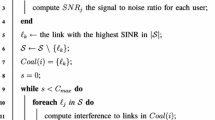Abstract
The emergence of small cells provides a cost-effective way to satisfy users’ explosive traffic requirements. The massive deployment of small cells, nevertheless, causes severe inter-cell interference in Orthogonal Frequency Division Multiple-Access -based cellular networks. As such, conventional interference management strategies may be inefficient and interference alignment (IA) has been proposed as a promising technology to cope with inter-cell interference. To perfectly align all interference in a reduced-dimensional subspace, IA transmitters generally call for global channel state information (CSI) across small cell networks through receivers’ feedback. However, the number of total feedback bits scales as the square of the number of small cells. Hence, IA achieves a greater multiplexing gain at the cost of substantial overhead. To enable a tradeoff between multiplexing gain and overhead reduction, in this paper we present a new metric termed average effective degrees of freedom (AEDoF), which embodies the average degrees of freedom of small cell networks with CSI overhead considered. Furthermore, for reducing the computational complexity, we propose a graph-based clustering algorithm to solve the formulated AEDoF maximization problem. Simulation results verify that our proposed algorithm is of low complexity and achieves the maximum spectrum efficiency among several existing clustering methods.












Similar content being viewed by others
References
Andrews, J. G., Claussen, H., Dohler, M., Rangan, S., & Reed, M. C. (2012). Femtocells: Past, present, and future. IEEE Journal on Selected Areas in Communications, 30(3), 497–508.
Cadambe, V. R., & Jafar, S. A. (2008). Interference alignment and degrees of freedom of the-user interference channel. IEEE Transactions on Information Theory, 54(8), 3425–3441.
El Ayach, O., Peters, S. W., & Heath, R. W. (2013). The practical challenges of interference alignment. IEEE Wireless Communications, 20(1), 35–42.
El Ayach, O., Lozano, A., & Heath, R. W. (2012). On the overhead of interference alignment: Training, feedback, and cooperation. IEEE Transactions on Wireless Communications, 11(11), 4192–4203.
Mungara, R. K., George, G., & Lozano, A. (2014). Overhead and spectral efficiency of pilot-assisted interference alignment in time-selective fading channels. IEEE Transactions on Wireless Communications, 13(9), 4884–4895.
Tresch, R., & Guillaud, M. (2009). Clustered interference alignment in large cellular networks. 2009 IEEE 20th international symposium on personal, indoor and mobile radio communications (pp. 1024–1028).
Chen, S., & Cheng, R. S. (2014). Clustering for interference alignment in multiuser interference network. IEEE Transactions on Vehicular Technology, 63(6), 2613–2624.
Zhang, Y., Zhou, Z., Li, B., Gu, C., & Shu, R. (2015). Partial interference alignment for downlink multi-cell multi-input-multi-output networks. IET Communications, 9(6), 836–843.
Kavasoglu, F. C., Huang, Y., & Rao, B. D. (2014). Semi-blind interference alignment techniques for small cell networks. IEEE Transactions on Signal Processing, 62(23), 6335–6348.
Wu, Z., Jiang, L., Ren, G., Zhao, N., & Zhao, Y. (2015). A novel joint spatial-code clustered interference alignment scheme for large-scale wireless sensor networks. Sensors, 15(1), 1964–1997.
Lertwiram, N., Popovski, P., & Sakaguchi, K. (2012). A study of trade-off between opportunistic resource allocation and interference alignment in femtocell scenarios. IEEE Wireless Communications Letters, 1(4), 356–359.
Peters, S. W., & Heath, R. W. (2012). User partitioning for less overhead in MIMO interference channels. IEEE Transactions on Wireless Communications, 11(2), 592–603.
Meng, Y., Li, J., Li, H., & Pan, M. (2015). A transformed conflict graph-based resource-allocation scheme combining interference alignment in OFDMA Femtocell Networks. IEEE Transactions on Vehicular Technology, 64(10), 4728–4737.
Castanheira, D., Silva, A., & Gameiro, A. (2014). Set optimization for efficient interference alignment in heterogeneous networks. IEEE Transactions on Wireless Communications, 13(10), 5648–5660.
Castanheira, D., Silva, A., & Gameiro, A. (2015). Limited Intersystem Information Exchange Method for Heterogeneous Networks. IEEE Communications Letters, 19(9), 1656–1659.
Almers, P., Bonek, E., Burr, A., Czink, N., Debbah, M., & Degli-Esposti, V. (2007). Survey of channel and radio propagation models for wireless MIMO systems. EURASIP Journal on Wireless Communications and Networking, 2007(1), 56–56.
Ruan, L., Lau, V. K., & Win, M. Z. (2013). The feasibility conditions for interference alignment in MIMO networks. IEEE Transactions on Signal Processing, 61(8), 2066–2077.
Bresler, G., Cartwright, D., & Tse, D. (2014). Feasibility of interference alignment for the MIMO interference channel. IEEE Transactions on Information Theory, 60(9), 5573–5586.
Yetis, C. M., Gou, T., Jafar, S. A., & Kayran, A. H. (2010). On feasibility of interference alignment in MIMO interference networks. IEEE Transactions on Signal Processing, 58(9), 4771–4782.
El Ayach, O., & Heath, R. W. (2012). Interference alignment with analog channel state feedback. IEEE Transactions on Wireless Communications, 11(2), 626–636.
Gou, T., & Jafar, S. A. (2010). Degrees of freedom of the user MIMO interference channel. IEEE Transactions on Information Theory, 56(12), 6040–6057.
West, D. B., et al. (2001). Introduction to graph theory (Vol. 2). Upper Saddle River: Prentice hall.
Arslan, M. Y., Yoon, J., Sundaresan, K., Krishnamurthy, S. V., & Banerjee, S. (2011). FERMI: a femtocell resource management system for interference mitigation in OFDMA networks. Proceedings of the 17th annual international conference on Mobile computing and networking (pp. 25–36).
Ning, G., Yang, Q., Kwak, K. S., & Hanzo, L. (2012). Macro-and femtocell interference mitigation in OFDMA wireless systems. IEEE Global Communications Conference, 5068–5073.
3rd Generation Partnership Project (3GPP). (2012). Further enhancements to lte time division duplex (tdd) for downlink-uplink (dl-ul) interference management and traffic adaptation (release 11). TR 36.828 V11.0.0.
Acknowledgements
This work is supported by the National Key Research and Development Program of China (2016YFB0501004), the National Natural Science Foundation of China (91638202, 91338115, 61231008, 61401326, 61571351), National S&T Major Project (2015ZX03002006), the Fundamental Research Funds for the Central Universities (WRYB142208, JB140117), the 111 Project (B08038), SAST (201454), and Natural Science Basic Research Plan in Shaanxi Province of China (2016JQ6054).
Author information
Authors and Affiliations
Corresponding author
Rights and permissions
About this article
Cite this article
Zhou, M., Li, H., Li, J. et al. Average effective degrees of freedom (AEDoF) maximization with interference alignment in small cell networks. Wireless Netw 24, 981–991 (2018). https://doi.org/10.1007/s11276-017-1499-9
Published:
Issue Date:
DOI: https://doi.org/10.1007/s11276-017-1499-9




